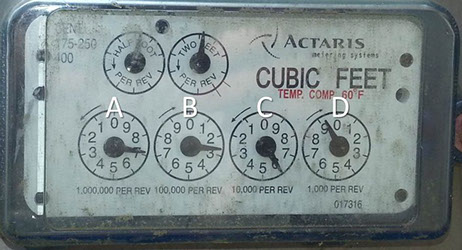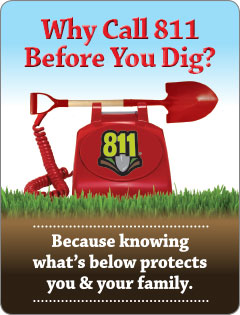Business FAQs
How do I report a natural gas emergency?
What do I do if I smell gas?
What is Natural Gas?
What are the advantages of natural gas?
How do I get gas service turned on?
How do I apply for gas service at a new location?
How do I read my gas meter?
Q: How do I report a natural gas emergency?
Call Mountaineer Gas’ Operations and Dispatch Center at 1-800-834-2070 24 hours a day to report a natural gas emergency.
Q: What do I do if I smell gas?
- Turn off all motorized equipment in the area or other sources of ignition
- Leave the area immediately
- From a safe location call us at 1-800-834-2070 or call 911
- Warn others to stay clear of the area
DO NOT DO ANY OF THE FOLLOWING:
- Operate telephones, light switches, electrical appliances/tools or other items that may be an ignition source
- Operate pipeline valves
- Enter structures where gas could accumulate
- Prematurely extinguish fires without stopping the flow of gas
Q: What is Natural Gas?
Natural gas is a fossil fuel called methane - a flammable gas formed deep in the earth. It is naturally odorless and colorless. A chemical called mercaptan is added to natural gas by utility companies - this chemical gives natural gas an odor similar to rotten eggs. The presence of this odor means there is a gas leak.
Like all fuels, natural gas requires the proper amount of oxygen to burn. When burning efficiently, a natural gas flame is blue in color. Any other color, such as orange, is a sign to contact a qualified heating and repair person. Incomplete combustion can produce carbon monoxide gas.
When used properly, natural gas is a safe, reliable, and efficient source for your business energy needs
Q: What are the advantages of natural gas?
Natural gas is a clean fossil fuel that can heat your home, heat water, dry your clothes, and cook your food. Natural gas provides nearly one-fourth of all the energy used in the United States.
- Natural gas has a high energy content (BTU)
- Natural gas is a clean fuel that has lower emissions compared to most other energy choices, including electricity
- Natural gas is produced right here in West Virginia and other areas of the United States
Q: How do I get gas service turned on?
Call toll-free at 1-800-834-2070 between 7:00 AM and 6:00 PM, Monday through Friday, except holidays and a Customer Service associate will assist you.
When you call, be prepared to provide the physical address of the meter location, your mailing address and a time when someone can be present for our service personnel to turn on the gas. Service orders are worked Monday through Friday, excluding holidays, and we need at least one business days notice to schedule an order.
Q: How do I apply for gas service at a new location?
Contact Mountaineer Gas at 1-800-834-2070 between the hours of 7:00 AM and 6:00 PM Monday through Friday except holidays. You will need to provide the address and possibly directions for us to locate where you will want service. Along with that, our customer service associates will ask for other information such as phone number, mailing address and your expected gas appliances.
They will also set an appointment time for one of our employees to meet at the site to advise you on meter and pipe location, as well as availability of gas service at that location. The company representative will also provide you with a booklet that helps explain the process from start to the meter being turned on.
Q: How do I read my gas meter?
The dials that record the amount of gas used are grouped together in a row of three or four on your gas meter. Each represents a single number in the reading. Here’s how to read the meter dials on the meter at your home:
- Read the meter dials left to right, writing down the numbers in the same order (left to right).
- If the hand points between two numbers, use the lower number. When it points between 9 and 0, always read it as 9.
- When a dial pointer appears to be exactly on a number, look at the dial to the right. If the pointer on that dial has not passed zero, the reading on the dial in question is the lower number.
Reading a Meter

Dial A - The hand is in between the 7 and the 8, when the hand is in between two numbers, use the lower number. Dial A’s number is 7. (this dial goes counterclockwise.)
Dial B - The hand is between the 2 and the 3, so this dial should be read as 2. (this dial goes clockwise.)
Dial C - The hand looks like it is on the 6, but it is between the 5 and the 6 because the dial to the right of it has not reached 0, so this dial should be read as 5. (this dial goes counterclockwise.)
Dial D - The hand is between the 9 and the 0, so this dial should be read as 9. (this dial goes clockwise.)
The correct reading for the sample meter is 7259. This means 725.9 thousand cubic feet (MCF) of gas. When billing, we round the last digit to the nearest whole number, in this case the billed reading is 726 MCF. You subtract the previous reading from this reading to determine amount used since the last reading.
Is Your Meter Accessible?
Even if you have an Automated Meter Reading technology meter, Mountaineer Gas representatives are required by the Public Service Commission of West Virginia to gain access to your gas meter at least once every 12 months. To provide the best service, make sure we can reach and read your meter.
- Keep shrubs trimmed; don’t block the meter.
- Secure your animals if you know there is an appointment scheduled for Mountaineer Gas to access your meter.
- Unlock gates that allow meter access.
- Never tamper with the meter or paint over the read dials.
- Do not chain or electrically ground anything to the meter.

